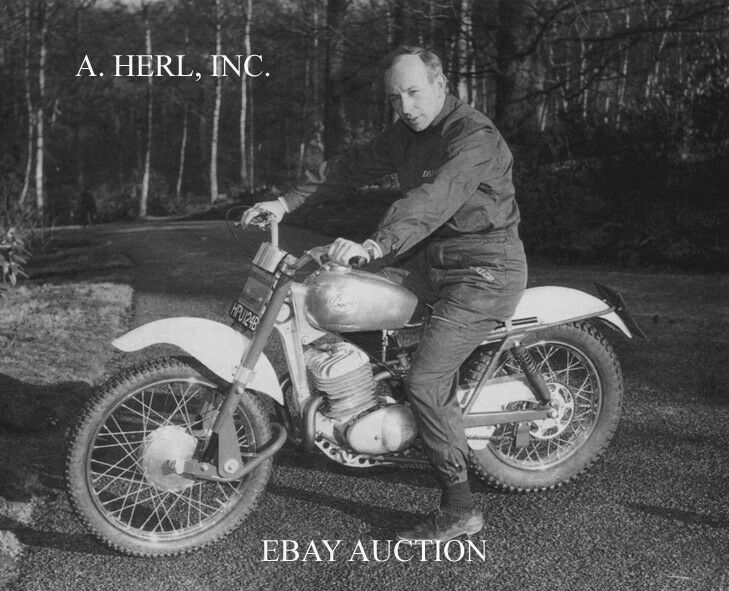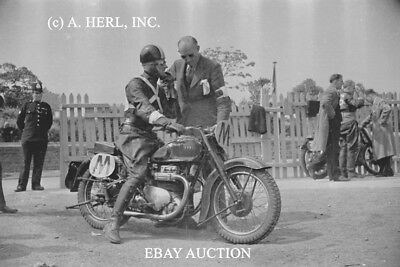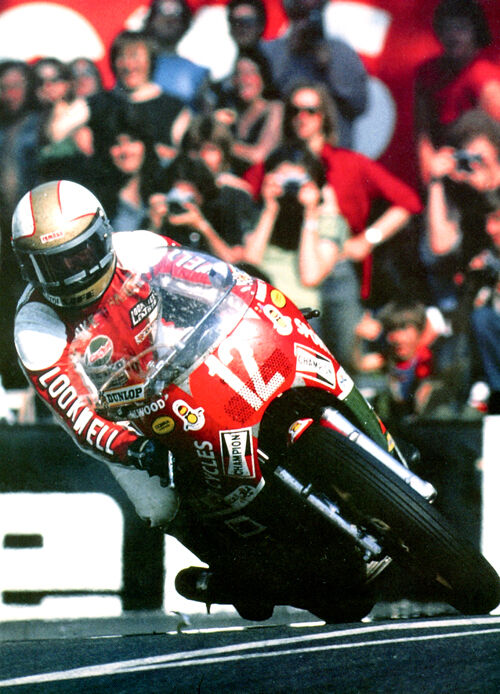-40%
Velocette 250cc works racer W.G. Dehany 1953 Ulster Grand Prix motorcycle photo
$ 5.14
- Description
- Size Guide
Description
A superb and rare photo ofBill (W.G.) Dehany
, seen in action with his immaculately prepared
250cc Velocette
during the
1953
250cc
Ulster
Grand Prix
which was ridden on
August 15, 1953
. This image shows excellent detail of his interesting racing machine.
Irishman
Bill Dehany
was a specialist of the Irish roadraces. In 1953, the year this photograph was taken, he won the 250cc class of he Enniskillen 100 with the photographed Velocette. That year he also finished 14TH in the Ultra Lightweight TT on the Isle of Man. He was known for his careful preparation and expertise his of his racing bikes.
This great photograph of the Grand Prix of Ulster was taken during the 250cc race of 1953. The race was won by Reg Armstrong (
Ireland
) on a NSU Rennmax with an average race speed of
81.76 mph
(
131,58 km/h
).
Velocette
is the name given to motorcycles that were made by Veloce Ltd, in Hall Green, Birmingham, England. One of several motorcycle manufacturers in
Birmingham
, Velocette was a small, family-owned firm, selling far fewer hand-built motorcycles than the giant BSA, Norton or Triumph concerns. Renowned for the quality of its products, the company was 'always in the picture' in international motorcycle racing, from the mid-1920s through the 1950s, culminating in two world championship titles (1949–1950 350 cc) and its legendary and still-unbeaten 24 hours at
100 mph
(
161 km/h
) record. Veloce, while small, was a great technical innovator and many of its patented designs are commonplace on motorcycles today, including the positive-stop foot shift and swinging arm rear suspension with hydraulic dampers. The company was founded by John Goodman (born Johannes Gütgemann and later known as John Taylor before formally changing his name to Goodman) and William Gue, as "Taylor, Gue Ltd." in 1905. Its first motorcycle was the Veloce. Later that year, John Taylor set up Veloce Limited, to produce cycles and related products and services. Veloce Ltd initially produced four-stroke motorcycles. The first two-stroke, built in 1913, was called a Velocette. This name was used for all subsequent models. He was joined in 1916 by his sons Percy and Eugene Goodman. Between 1913 and 1925, Veloce only produced expensive, high-quality two-stroke motorcycles of (nominally) 250 cc, which gained an excellent reputation, and which were entered in competitions, such as the Isle of Man TT, with some success. The single-cylinder machines had many advanced features, such as a throttle-controlled oil pump, which set them apart from other manufacturers' products. The factory gradually developed this machine from the 'A' series and variants (A, AC2 - coil ignition, two-speed gearbox, AC3 - three speed gearbox, etc.), then the 'H' series, the model U and variants, culminating in the model GTP in 1930, which was produced until 1946. The GTP was a reliable lightweight motorcycle with good steering and power delivery. In the early 1920s, Veloce realized that in order to grow as a company, it needed a new machine of advanced specification and developed an overhead camshaft (OHC) 350 cc engine, which became known as the 'K' series, introduced in 1925. After a year of teething troubles with this new design, Veloce entered the model KTT into racing events such as the Isle of Man TT and Brooklands races, and the reliability and sweet running qualities of their new engine led to a long string of racing successes. The roadster models developed from this initial model K were the Velocette KSS (super sports), KTS (touring sports), KTP (twin exhaust ports), KN (normal), and a few variations. The OHC engine series continued for roadsters until 1948, when the final KSS versions were produced, with rigid frames and Dowty air-sprung telescopic forks. Accurate valve timing was accomplished through the pioneering use of stroboscopic lamps (see timing light). The 'K' series showed an excellent turn of speed and reliability and soon the factory developed racing models to compete in the Isle of Man TT. In 1933, the company decided to introduce a new line of overhead valve (OHV) machines, in order to cut production costs and make a more affordable motorcycle. The K series was expensive to produce, requiring selective hand assembly of the shaft-and-bevel camshaft drive; it was determined that a simpler OHV design would be quicker to build and require less skilled labour to assemble. The first of these new machines was the MOV, using a 250 cc engine of 'square' dimensions (
68 mm
bore x
68 mm
stroke). It was an immediate sales success, having lively performance for the time (
78 mph
), and proved a reliable machine with excellent road manners. From this machine, by lengthening the stroke of the crankshaft, the Velocette MAC 350 cc was introduced in 1934. It proved even more popular than the MOV, and became a real money spinner for the company, bringing much needed capital into the firm. In 1935 an entirely new machine was introduced, based on the two previous OHV models, the Velocette MSS of 500 cc. A new, heavier frame was utilized with the intention that the machine could serve as a sidecar hauler. This new frame was developed from the mkV KTT racing machine, and was shared with the KSS MKII of 1936-48. The MSS also proved very popular and profitable for Veloce. After the Second World War, the company sought to capture what it saw as a developing need for personal transport and created (with the help of Phil Irving of Vincent fame) the model LE. This was a 192 cc watercooled flat twin with side-valves, a pressed steel frame and telescopic forks and swingarm. It was sophisticated and expensive. Unfortunately it proved less successful than the firm had anticipated and although it became Veloce's best selling model ever, the massive tooling costs for this all-new machine were barely recouped. It did see widespread adoption by British police forces for urban patrol. At the time Metropolitan Police Officers on foot patrol were required to salute Sergeants and Inspectors. With the introduction of the Velocette LE, this became dangerous, requiring the officer to take his hand off the handle bars, and so the rider was to allowed to show his respect with a smart inclination of his head, or to put it another way, to give a smart nod and the bikes became known as 'Noddy Bikes'. At the 1947 TT, the company won the first four places in the Junior race, and in 1950 they were the 350cc World Champions. In 1960, Velocette introduced the Viceroy, a very unusual 250 cc opposed twin two-stroke scooter. Unique to the Viceroy was the front mounted twin-cylinder engine, and the fuel tank mounted under the front legshield. The engine itself was extremely compact, and connected to the rear-mounted clutch and transmission by a drive shaft from the engine-mounted flywheel. With electric start, 12 volt electrics, a very low centre of gravity, power over 15 hp and a reported comfortable cruising speed of
65 MPH
(
105 km/h
), performance, handling and features of the Viceroy were first class. Unfortunately the scooter came as market forces and rider preferences were changing, and the Viceroy was not a sales success. The late 1960s were the last years of production for Velocette motorcycles, production for the Velocette Viper and Vogue ending in 1968, "Special", Scrambler and Endurance in 1969, and MSS Venom and Velocette Thruxton in 1970. Veloce Ltd. closed in February 1971.
This is a very nice and very rare
non period
photo that reflects a wonderful era of 1950s motorcycle history in a wonderful way. This is your rare chance to own this photo, therefore it is printed in a nice large format of ca. 8" x 12" (ca. 20 x
30 cm
). It makes it perfectly suitable for framing!
Shipping costs will only be $ 7.00 regardless of how many photos you buy. For 5 or more photos, shipping is free!
(Note: A. Herl, Inc. does not appear on photo, for ebay purposes only)
No copyright expressed or implied. Sold as collectable item only. We are clearing out our archives that we have gathered from various sources.
All items always sent well protected in PVC clear files
and board backed envelopes.
We have photographs that came from professional collections and/or were bought from the original photographer or press studio! They are all of professional and excellent quality.
After many decades of professionally collecting photographs and posters we are clearing out our archives. They make the perfect gift and are perfectly suited for framing. They will look gorgeous unframed and will be a true asset nicely framed with a border. They are a gorgeous and great asset in every home, workshop, workplace, restaurant, bar or club!
First come - first served. And you can always contact us for your requests. Please ask any questions before the auction ends.









